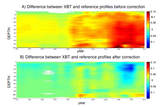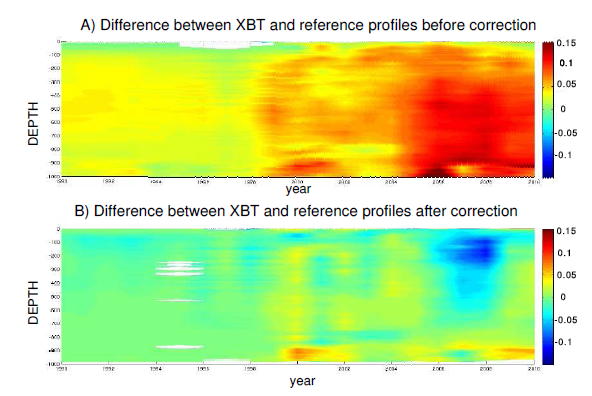R&D Coriolis team uses Hamon et al 's method to correct the temperature offset and depth bias due to unrealistic fallrate equation.
Empirical XBT Temperature and depth correction, Hamon et al (2011)
Different issues with the data of eXpendable BathyThermograph (XBTs) exist and, if not corrected, they are known to contribute to anomalous global heat content variability. The XBT system measures the time elapsed since the probe entered the water and thus inaccuracies in the fall rate equation result in depth errors. There are also issues of temperature offset but usually with little dependence on depth. The correction given by Hamon et al is divided in two parts: first the computation of the thermal offset then the correction of depth.To evaluate the temperature offset and the error in depth, an empirical model is developed from co-localised reference profile. Those profiles must fill all the following conditions:
- geographic position in a 3km ray
- date in +/-15 days temporal frame
- a maximum average temperature difference of 1°C
- a bathymetric difference inferior to 1000m
- profiles can't be XBT measurements
- quality flags different from 3 and 4 (suspicious and bad quality).
The temperature offset correction:
This correction provide a constant value applied to the whole profile as a function of the year and the category of XBT: shallow XBT or deep XBT (e.g. maximal depth >=500m). The values are computed by the difference of each XBT profile with its reference profile in the layer 30-50m (below the surface layer and where depth errors are usually small enough to explain the observed bias). XBT and reference profiles are interpolated on standard levels from 0 to 1000m and reduced to a resolution of 10m before the calculation. Only points with a small vertical gradient (e.g. <0.0025 °C/m) are used to compute those corrections. The final offset is the median of all those differences.
The depth error correction:
Results of this depth correction are second order polynomials as a function of depth for each year, the depth and category of XBT profile. In this second step there are four different categories of XBT profiles: deep and hot, deep and cold, shallow and hot, shallow and cold (e.g. maximal depth 500m* and average temperature 11°C**). To evaluate the error in depth we use the following formula:
In addition, criterai on a minimum number of collocations per level and a maximum value of depth error are used to improve the estimated median profile fitted to the raw depth errors in each of the four categories. Then we fit a second order polynomial on the median depth errors and we get three coefficients:
Ztrue − Z = aZ2 + bZ + c
The c coefficient is replaced by the mean of the depth error in the layer 30-200m to ignore the noise due to the surface layer. The results depend of the dataset used for the the colocalisations and the results are certainly more consistent when there are numerous accurate reference profiles.
XBT correction in CORA
Before CORA3.2 a Hanawa+Levitus correction was applied on XBT and since CORA3.2 we use Hamon et al method.
How to use XBT with thermal offset and depth corrected?
For XBT profiles (PROBE_TYPE=10 in the index files) the corrected values are reported in the ADJUSTED fields: TEMP_ADJUSTED field for the temperature corrected from the thermal offset and DEPH_ADJUSTED for the depth corrected. The depth correction which stretches the values of depth can lead to negative depth value on the first level of some profiles (depending on the year, on the category of XBT and on the value of the first level). Those negative depth values have been retained in the DEPH_ADJUSTED field but the quality flag has been set to 4. Those negative values are found for between 50 and 70% of the profiles each year. Users are free to reject or not this first level (notice that the correction applied in the first layer is not that relevant). It appeared to us that some XBT profiles of the CORIOLIS and CORA databases have values of depth incorrectly stored in the field PRES. As we were not able to find the origin of this error, we computed the depth correction assuming that we had a depth and not pressure information. However to allow future corrections, for those XBT, we leave the corrected depth in the PRES_ADJUSTED parameter.
** 500m and 11°C respectively correspond to the level and the temperature where a significant minimum is found in the distribution of depth bias and split temperatures and immersions in two categories.
K. Hanawa, P. Rual, R. Bailey, A. Si, and M. Szabados. A new depth-time equation for Sippican or TSK T-7, T-6 and T-4 expendable bathythermographs (XBT).Deep-Sea Res. Part I, 42:1423–1451,1995.
M. Hamon, G. Reverdin, and P.-Y. Le Traon. Empirical correction of XBT data. J. Geophys. Res., 2011.
http://journals.ametsoc.org/doi/abs/10.1175/JTECH-D-11-00129.1
S. E Wijffels, J. Willis, C. M. Domingues, P. Barker, N. J. White, A. Gronell, K. Ridgway, and J. A. Church. Changing Expendable Bathythermograph Fall Rates and Their Impact on Estimates of Thermosteric Sea Level Rise.J. Climate, 21:5657–5672. doi: 10.1175/2008JCLI2290.1, 2008.



